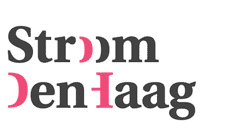There, I Fixed It: Reto Pulfer
13 March thru 15 May 2011Location: Hogewal 1-9, The Hague
Survey page There, I Fixed It: click here
'There, I Fixed It' refers to a mentality, a way of looking at materials and problems that is both bold and unexpected. Unruly solutions to urgent problems.
Reto Pulfer (1981, Bern, lives and works in Rome) is a self-taught artist. He shows with his work the unpredictability of the moment, the state between chaos and process when everything is still fluid. He distrusts great schemes in which everything has its fixed place. He examines the inexhaustible reservoir of possibilities that art offers to express yourself and to help you communicate. His music, language, objects, performances and installations take away the comfortable distance of the viewer: everything is done to pull the viewer into the game.
The term 'Zustand' is a central concept in the work of the artist. It means a state, situation, the condition something is in. A 'Zustand' is complete in itself but the stability is short lived. The artist lets go of his authority on which the meaning of the work might have been based. In the mind of the visitor the work undergoes an unprecedented transformation and becomes therefore uncontrollable. It has a life of its own. 'Zustand' is also the title of a series of exhibitions Pulfer curated.
Pulfer uses materials in a unique way. He colors secondhand fabrics and makes tents, shapes and wall coverings from them. Many of the textiles with which he works were previously used in his own house or someone else's. The tents are a way for him to create his own space in the white cube of a gallery or museum. He told us during his artist talk at the opening of the exhibition that using second-hand materials is more interesting to him because these materials have a history, and very often he knows where the materials come from.
For 'There, I Fixed It', Pulfer has created a new work: 'ZR Blechschubladen'. In a tent made of different sorts of textile, tables are placed on which Pulfer placed objects, small things, fragile ceramic sculptures, and tin scraps. The work is at the same time closed off, offering you a private and intimate viewing space within the larger exhibition space and reaches out into the room and to the other works. It makes an expansive gesture while also taking us in.
Pulfer speaks about his own work in terms of a game, which is reflected in his use of materials, the system in which some elements reappear and change, the made-up words and puns in the titles of his works. A quote from an interview in Mousse Magazine illustrates this fittingly:
"Quite some titles of works give technical information: if a work has ZR in its title it means it is made with zippers and parts of it can be detached and attached in several ways. Such as the following mostly textile works: ZR Boot, ZR Der Exhibitionistische Eulenpinguin, ZR Autswaus O, ZR Potzwaus, ZR Innenzelt, ZR Der Exhibitionistische Bartpinguin, ZR Fliegzeug, ZR Spotwaus."
What else?
"If a work has the letter "O" in its title, it means it has "O-quality:" like the letter O, it can be rotated. As in ZR Autswaus O, O Flanktons, or O Planktoms."
And?
"Ofaz means a sofa: visitors can sit on it - like Ofaz so far, so good, and Ofaz 1442."
And often there are numbers in the titles: Ofaz 1442, Steinspiel in 27 Zuständen, Aquariumspiel in 128 Zuständen, Die 60 Zustände des Z Feld, etc. Are these also part of a system?
"A number in the title usually indicates the total number of different ways to install a piece. Ofaz 1442 has six wooden boards to sit on, each board can be placed in any of the six fields (6 x 5 x 4 x 3 x 2 = 720), and furthermore each board can also be flipped upside-down (720 x 2 = 1440). There are two guitar strings I used in the performance to make music (1440 + 2 = 1442)."
The complete interview is online: www.moussemagazine.it
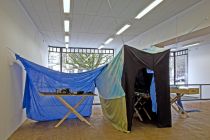
Reto Pulfer, ZR Blechschubladen, 2009-2011
photo: Rob Kollaard, courtesy Stroom Den Haag
photo: Rob Kollaard, courtesy Stroom Den Haag
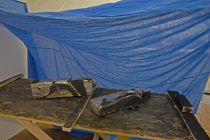
Reto Pulfer, ZR Blechschubladen, 2009-2011
photo: Rob Kollaard, courtesy Stroom Den Haag
photo: Rob Kollaard, courtesy Stroom Den Haag
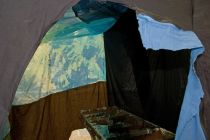
Reto Pulfer, ZR Blechschubladen, 2009-2011
photo: Rob Kollaard, courtesy Stroom Den Haag
photo: Rob Kollaard, courtesy Stroom Den Haag
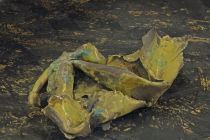
Reto Pulfer, ZR Blechschubladen, 2009-2011
photo: Rob Kollaard, courtesy Stroom Den Haag
photo: Rob Kollaard, courtesy Stroom Den Haag
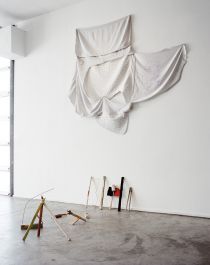
Reto Pulfer, Instrumente, 2008/2009

















